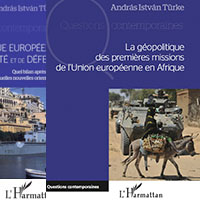You are here
Deutsches Institut für Entwicklungspolitik / Briefing Paper
Beyond nature-based solutions: the case for integrated nature-climate action
1. Nature-based Solutions (NbS) have been gaining prominence across the Rio Conventions primarily as a means of addressing climate change with co-benefits for nature and humans. However, they have also faced significant criticism for enabling greenwashing, encouraging market-driven approaches and not addressing the root causes of environmental degradation. Some critics argue that NbS divert attention from urgent transformative actions such as decarbonisation and systemic economic reforms.
2. We present the case for a broader framework, centred around the concept of Integrated Nature-Climate Action (INCA), which extends beyond NbS to drive the structural changes essential for tackling climate change, biodiversity loss and desertification, while delivering positive outcomes such as supporting livelihoods, addressing inequities and upholding the rights of Indigenous Peoples and Local Communities. We provide examples of INCAs with significant, tractable benefits for people and nature, including the removal of environmentally harmful subsidies, land rights recognition and circular economic transitions.
3. We argue that the wide range of actors mobilised by INCAs would increase the finance available to fill the deficit for climate and biodiversity action. While tracking the impact of these actions could be challenging, existing United Nations (UN) initiatives could provide models for ensuring the integrity of INCA. A clear definition and set of standards must also be agreed upon to avoid the pitfalls that plague NbS. Careful oversight from stakeholders and rightsholders is vital to ensure legitimacy and that the uptake of INCA does not favour one outcome over others.
4. Policy implications: Moving beyond NbS to pursue an inclusive INCA concept can help address the systemic drivers of the global polycrisis. With synergies between the Rio Conventions expected to be a key focus of the upcoming Conference of the Parties for the UN Framework Convention on Climate Change (COP30), there is a clear policy window to broaden the scope of interventions relevant to all three conventions and engage a more diverse array of actors to support enhanced coordination. This is essential for transitioning towards a regenerative economic system that works for people and the planet.
Let’s be honest – both Sweden and Germany need the immigrants
Population growth due to immigration is often portrayed as a problem rather than a success. This is deeply problematic, not least because Sweden – like Germany – depends on immigration to meet its growing labour market needs
Eine kohärente Migrations- und Flüchtlingsstrategie ist überfällig
Migration wird in Deutschland oft verzerrt und polarisiert diskutiert – dabei ist sie dringend notwendig. Und das Leugnen dieser Realität behindert weiterhin die Entwicklung einer kohärenten nationalen Strategie.
Economic self-interest in German development policy: what might that look like?
Calls for development policy to place greater emphasis on national self-interest are growing louder in many donor countries, including Germany. There are indeed good reasons to dovetail Germany’s international policies more effectively. Synergies between develop-ment cooperation (DC), foreign trade promotion and research partnerships have not been harnessed systematically to date, yet they could serve the interests of both Germany and its partner countries alike. Moreover, Germany is facing geopolitical competition from actors who have long been using their DC proactively to pursue strategic interests.
We advocate adopting a development policy that pursues German and European interests in those areas in which they are compatible with development policy objectives. Instead of focusing on the interests of individual companies, it is important to identify long-term ‘win-win’ potential, for example through a more strategic approach to planning DC offers that involves the private sector and ministries more actively prior to intergovernmental negotiations with the partner countries.
At the same time, we warn against subordinating DC to foreign economic policy objectives. Conditions such as tied aid provisions that link financial cooperation to business contracts for German/EU companies are expensive, inefficient and counterproductive in development terms. In addition, this approach would risk losing sight of Germany’s overarching interest in solutions to global problems, such as peacebuilding and climate and biodiversity protection.
We set out five guidelines for a development policy strategy that takes due consideration of Germany’s own interests without harming the partner countries:
1. Avoid strict tied aid provisions. These would be inefficient in development terms and would be of little benefit to German companies. As an export nation, Germany should comply with freedom of contract rules.
2. Pursue the interests of German society as a whole where they align with DC objectives. We distinguish between Germany’s global interests and those of individual companies. DC projects should align economic interests with the common good in the partner country.
3. Develop offers strategically prior to intergovernmental negotiations. The most effective synergies are generated if the private sector and other ministries are involved in preparing DC initiatives at an early stage. To do so, Germany needs to define joint national goals, coordinate ministerial instruments to achieve these goals and evaluate contributions by the private sector in advance.
4. Create strategic partnerships that serve as models. Germany has established a number of bilateral partnerships, especially on energy, raw material security and migration. None of these is exemplary in terms of effective interministerial coordination, private sector involvement or demons-trable benefits for both of the countries involved. At least one flagship project in each of the areas mentioned would make Germany attractive as a credible partner.
5. Expand minilateral formats with European states and influential third countries. Triangular and quadrilateral cooperation with ‘global partners’ and donor countries that share the same or similar interests can help advance Germany’s interests in international development for the common good.
In search of a Plan B: like-minded internationalism and the future of Global development
The international landscape in mid-2025 is characterized by a retreat from liberal institutionalism, exemplified by the United States' withdrawal from the Sustainable Development Goals and its adoption of transactional, power-based international relations, as well as its potential withdrawal from some multilateral bodies. In this context, this paper argues that traditional models of universal multilateralism are increasingly untenable, and that new forms of collective action grounded in shared interests and normative alignment are both necessary and feasible. This paper revisits and applies the historically rooted concept of “like-minded internationalism,” arguing for its renewed relevance under current geopolitical conditions.
Die ›UN80‹-Reforminitiative als Chance für Erneuerung
In its 80th year, the UN faces a significant crisis. Severe funding shortfalls are forcing the organisation to make cuts. However, the focus should not be solely on cost savings. Reform presents an opportunity to address unresolved challenges and to restructure the UN both institutionally and politically.
Foreign aid transparency amid politicization
Motivation: In recent years, foreign aid donors have tried to becomemore transparent, often by sharing information digitally. However,the politicization of individual aid projects has resulted in biasedreporting, raising doubts about the legitimacy of aid in general. Wetherefore examine whether increased transparency leads to greatergovernment effectiveness and public trust. Purpose: Government agencies typically assume that greatertransparency in public administration improves understanding ofbureaucratic actions, thereby fostering trust in the government. Inforeign aid, openness is believed to enhance public confidence andimprove the effectiveness of governments. However, recent publicand political reactions to the disclosure of aid information cast doubton these optimistic assumptions. Approach and methods: Using our sender-mediator-receiver modelof a “fragile transparency loop,” we analyse how communicationbreaks down in German foreign aid. First, we focus on Germany as adonor that shares information through a digital transparency portal,examining the sender side. Second, we investigate the mediator sideby conducting a qualitative content analysis of German online mediaarticles. Third, we examine the receiver side by disaggregating theGerman public into several subgroups. Findings: Our empirical findings suggest that, while donors assumea virtuous transparency loop, the reality can resemble a fragiletransparency loop that is easily disrupted. The government maywithhold information; mediators may spread misinformation; and thepublic may not receive information neutrally. These dynamics explainwhy, despite increasing transparency, donors may not achieve theintended increases in government effectiveness and public trust. Policy implications: Donors should find a balanced approach toforeign aid transparency that upholds democratic accountabilitywhile avoiding information overload. Aid bureaucracies should tailortheir disclosure to serve different audiences, including professionalswith development expertise and the wider public, who may havepreconceptions or be uninformed about foreign aid.
Der Flüchtlingsbegriff in Afrika: Ein Fall von politischer Auslegung - Aufnahme Geflüchteter und fließende kategoriale Übergänge im Kontext der Dekolonisierung
Die Organisation fur Afrikanische Einheit (OAU), heute Afrikanische Union (AU), schloss 1969 eine Fluchtlingskonvention, deren Regelungen zum Teil von jenen der Genfer Fluchtlingskonvention von 1951 abweichen. In der Fluchtlingskonvention der AU wird explizit die politische Natur Gefluchteter anerkannt und eine Begriffsbestimmung vorgenommen, die in den politischen Umwalzungen im Kontext von Kolonialisierung und antikolonialer Kampfe verankert ist. Sie definiert Gefluchtete als Menschen, die vor Ereignissen fliehen, die ihren Ursprung in ≫externer Aggression, Besetzung, [und] auslandischer Beherrschung≪ haben (Artikel 1. 2). Der damalige politische Zeitgeist basierte auf Antikolonialismus, Panafrikanismus und afrikanischer Solidaritat. Er pragte einen entsprechenden Humanitarismus und wirkte sich unmittelbar auf die offenen Fluchtlingspolitiken auf dem Kontinent aus. Dementsprechend nahmen die damals gerade unabhangig gewordenen afrikanischen Staaten Menschen aus den noch nicht befreiten Kolonien des Kontinents auf. Sie forderten und unterstutzten den Widerstand gegenuber der kolonialen Besetzung, indem sie sowohl materielle als auch moralische, militarische, ideologische und politische Unterstutzung boten. Insbesondere nahmen sie Afrikaner:innen auf, die vor den durch diesen Widerstand erzeugten gewaltsamen Gegenreaktionen flohen. Diese Unterstutzung machte eine Unterscheidung zwischen Gefluchteten auf der einen und politischen Aktivist:innen und Kampfer:innen auf der anderen Seite fragwurdig. Den unabhangig gewordenen Landern erschien es deshalb politisch inkoharent und unlogisch, antikoloniale Kampfe zu unterstutzen und zugleich Afrikaner:innen, die vor ebendiesen Kampfen aus ihren Landern flohen, das Asyl zu verweigern.
Development policy: don't overpromise and underdeliver
The global crisis in development cooperation will not be resolved by making exaggerated promises about what it is capable of achieving. Instead, the focus should be on improving people’s living conditions tangibly. Adding all kinds of secondary objectives often means that none of the goals can realistically be reached. Tightening resources are forcing projects to focus on more specific and narrow objectives.
Entwicklungspolitik: Nicht zu viel versprechen
Die weltweite Krise der Entwicklungszusammenarbeit lässt sich nicht durch Maximalversprechen im Hinblick auf die Leistungsfähigkeit dieses Politikfelds lösen. Hauptziel muss die Verbesserung der Lebensbedingungen vor Ort bleiben – eine Überfrachtung mit Nebenzielen führt oft nur dazu, dass kein Ziel mehr realistisch erreicht werden kann. Immer knappere Ressourcen zwingen Projekte ohnehin, sich thematisch zu fokussieren.
Political connections and participation in global value chains: evidence from MENA firms
We use new data on political connections from the World Bank Enterprise Surveys to examine the impact of connections on firms' participation in international trade through global value chains (GVCs) for six lower middle income MENA countries and territories (Morocco, Tunisia, Egypt, the West Bank and Gaza, Jordan, and Lebanon). Our findings add to the literature on “hidden protection” and corruption in the region: trade- and investment policies and regulations are tailored to benefit or protect politically connected firms. Our findings suggest that politically connected firms are more likely to participate in GVCs by 9.8 percentage points and that the intensity of their participation in GVCs increases by 4.1 percentage points. Combining political connections and grand corruption increases firms' participation in GVCs by 13.6 percentage points.
Navigating the tides of conservation and conflict: The political ecology of Mangrove Ecosystem Sustainable Use and Custody Agreements in the Gulf of Guayaquil, Ecuador
Territorial Use Rights for Fisheries (TURFs) are a rights-based management strategy that grants area-based fishing rights to specific community groups. In Ecuador, following immense mangrove deforestation caused by industrial shrimp farming, TURFs have been implemented through Mangrove Sustainable Use and Custody Agreements (AUSCEMs, for its Spanish acronym), driven by grassroots demands to conserve remaining mangroves and recognize ancestral territorial rights. This article examines the power-laden dynamics of these agreements in the Gulf of Guayaquil, Ecuador through ethnographic research in two fishing communities. We analyze historical and ongoing conflicts and reveal how multi-scalar power—across visible, hidden, and invisible forms—shapes access to and control over mangrove resources, often reinforcing inequalities and epistemic injustices. Our findings highlight how funding inequities, limited tenure security, and rising threats from organized crime compromise community-led conservation. For this management approach to succeed, it is essential to close funding gaps for stewardship and innovation, address security and service disparities, recognize local ecological knowledge, and fully honor ancestral territorial rights to promote equitable, sustainable governance.
Localizing development to the grassroots: potentials and limits of engaging with community groups
Amid rising restrictions on foreign funding, localization—directly funding local groups—is seen as a path to more effective, locally owned aid. This policy brief examines whether donors should shift support from large civil society organizations to grassroots community groups.
Foreign aid, power, and geopolitics: reflections on development cooperaton in a more fragmented world
The Trump administration is pursuing an explicitly anti-multilateralist policy rooted in national sovereignty, geopolitical calculation, and transactional economics. Conspiracy theories played a significant role in justifying actions like the dismantling of USAID. Global norms, including the SDGs, are cast as threats to U.S. interests precisely because they promote forms of cooperative governance. The withdrawal from international organizations, disregard for established norms (even to the point of military threats), and blunt pressure on other nations—such as the baseless accusations of “genocide” against South Africa—signal a paradigm shift. It redefines the balance between values and interests, privileging short-term political dominance over long-term global cooperation.
Establishing the effect of COVID-19 lockdown policy on the resilience of facility-based delivery in Kenya: a multi-method study
Background: Amidst the COVID-19 pandemic, lockdown policies emerged as pivotal measures to contain viral transmission. Questions arose about whether their implementation challenged access to care, particularly in regions with fragile or less resilient health systems, such as sub-Saharan Africa. Robust evidence on the effect of lockdowns on healthcare access remains sparse, partly due to a lack of suitable data. We addressed this gap and assessed the effect of the COVID-19 lockdown policy on facility-based delivery during the first pandemic wave in Kenya. Methods: We triangulated findings from two independent quantitative analyses, exploiting the fact that lockdowns in Kenya were implemented only in selected counties. First, we used nationally representative repeated cross-sectional surveys from 2018 and 2020, applying a pre-post-test design with independent controls. Second, we analyzed monthly data from the Kenya Health Information System (Jan 2019–Nov 2020) using an interrupted time series (ITSA) with independent controls, with April 2020 set as the interruption point. Results: The controlled pre-post analysis found no significant effect of lockdowns on facility-based delivery in lockdown vs. non-lockdown counties. The ITSA showed an immediate increase of 4.97% (CI: 0.51%, 9.43%) in facility deliveries in lockdown counties, followed by a significant monthly decrease of 0.97% (CI: -1.60%, -0.34%) compared with non-lockdown counties. Conclusion: We found no overall effect of lockdowns on facility-based deliveries. Our results suggest that, when managed well, lockdowns do not necessarily disrupt access to maternal health services—demonstrating elements of resilience even under crisis conditions. These findings underscore the value of context-specific, adaptive strategies to ensure continuity of essential services during health emergencies. Future research should explore localized and socioeconomic factors shaping responses to public health interventions and further examine how resilience can be strengthened at all levels of the health system.
'Capital grabs back': towards a global research agenda on the land grabbing-land reform/restitution nexus
Capital is grabbing back land allocated through diverse national land reform and landrestitution programmes globally. This article critically analyses this trend, which has so far received insufficient attention from land grab scholars. Drawing from independent research in South Africa, Bolivia, Canada, and Zimbabwe, we define a future research agenda investigating the capital segments and grabbing mechanisms involved as well as the factors that encourage or retard capital in grabbing back redistributed and restituted lands. We point to the need for further research into the land grabbing-land reform/restitution nexus in different geographic contexts and its implications for future land and agrarian struggles.
The Global South and US trade policy: structural exposure and economic vulnerability in selected Latin American countries
This paper analyses the structural vulnerabilities of Latin American economies amid recent United States (US)-China tariff escalations and identifies strategic opportunities emerging from these shifts. Based on descriptive bilateral trade data from 2023 for the largest Latin American economies – Argentina, Brazil, Chile, Colombia and Mexico – the study assesses exposure to US tariffs at the industry level. It further highlights sectors with the potential to benefit from diverted trade flows in the context of trade polarisation between China and the US. The degree of exposure varies across countries, depending on export structure and trade partners. While the tariff conflict may enable some countries to expand exports to China or the US, most Latin American economies – except Mexico – export their largest share of their manufactured goods within the region. Strengthening regional trade integration can therefore enhance resilience to external shocks and support technological upgrading.
Melike Döver and Martin Middelanis are researchers at Freie Universität Berlin in Germany.
The Global South and US trade policy: structural exposure and economic vulnerability in selected African countries
United States (US) trade policy has undergone a series of significant changes introducing far-reaching uncertainty for trading partners in both the short and long term. Among the most vulnerable to these changes are low- and middle-income countries. Anticipating the potential impact of proposed or enacted US trade measures ex-ante is difficult. Therefore, this discussion paper examines the structural vulnerabilities of a selection of African countries – Lesotho, Madagascar, Côte d’Ivoire, South Africa, and Tunisia – to recent shifts. Using descriptive trade data, the paper maps direct and indirect channels of exposure and highlights the structural constraints that amplify vulnerability. While Africa is not among the most directly exposed regions, several countries face significant risks due to concentrated export structures, reliance on a few trade partners, and limited capacity to redirect trade in the short term. This highlights the strategic importance for African countries to strengthen regional integration, industrial upgrading, and reduce external dependencies.
Sascha Berndt and Andreas Edele are trade policy experts at Deutsche Gesellschaft für Internationale Zusammenarbeit (GIZ) GmbH.







